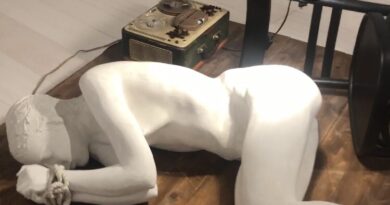Art Galleries in Paris: Don’t You See the Ghosts
In Paris, where galleries are open these days, as are all clothing stores, in general: Shops while the museums are closed (I understand who can), there is currently one in the rooms of the Marian Goodman Gallery in the Marais exhibition by French artist Christian Boltanski. It is his first exhibition since the big retrospective at the Center Pompidou a year ago, which ended exactly one day before the tough French lockdown in March 2020 and was a retrospective that took your breath away because it saw the viewer so relentlessly confronted the great Boltanski themes: time, transience, death.
Even visitors who happened to get lost in the rooms, for example because the Francis Bacon retrospective taking place next door was overcrowded, and who had never heard of Christian Boltanski, knew immediately, without needing any explanation, that the Holocaust was here was in the room. You can feel it in Boltanski’s work without being named. He is like an invisible companion.
Boltanski was born in Paris Born to a Catholic mother and a Jewish father, who was hidden by his brave wife during the German occupation in a cavity in the floor on the first floor of their common house. So he survived. And so Christian Boltanski was born as the youngest of three sons, a few days after the liberation of Paris, which also gave his father freedom again. Marked by this life-threatening experience, the family remained forever, which moved closer than close together and only ever left the house as part of the family, which can be read very touchingly in the book “Das Versteck”, which Boltanski’s nephew Christophe Boltanski published in 2015 (in German 2017, Hanser-Verlag) and tells the story of this family based on the house in which the father was able to hide from the murder.
A work that reminds of the dead
As an artist, Boltanski works with media as diverse as photography or sound installation (the only thing he never does: painting), but he is probably most famous for his installations. Often they consist of objets trouvés, from found objects, whereby the decisive factor for Boltanski is always that someone has once owned them: Where are the previous owners? his works ask. And so remember the dead.
The current exhibition “Après”, which you enter almost reverently because you can, because it exists, because you don’t have to stream art here, but can experience art with all your senses, also revolves around the absent. And as always with Boltanski, they are only hinted at here, and are all the more noticeable in omissions.
New works were created during the lockdown, during the corona pandemic. In the first room there are ten mobile tables on which sheets pile up to form mountains. “Les Linges” is the name of the work, “The bed linen”. The visitor is left with his associations, which, because the whole thing is immersed in an aseptic atmosphere by neon light, inevitably move towards the hospital or morgue. If you stand still enough, you will notice at some point that children’s faces flash on the walls at irregular intervals. Never long enough to really see them, but it makes you feel like you are the only person in the room not alone, but surrounded by ghosts.
“Après” is the title – but “after” what?
And what might the title of the exhibition mean? “Après”, which also materializes as blue neon lettering – After thatbut after what? After the live? In the basement you will be greeted by an installation consisting of four canvases, arranged in an X-shape, one for each direction. Peaceful nature scenes can be seen on all of them. A sky bathed in flaming pink with birds. A snowy forest. The sun setting in the sea. Grazing deer. If you stand still here long enough, you will see a similar spectacle as above. Again and again an interfering image flashes into the idyll. At first you hardly notice it, the visual twitch is so brief, but once the brain has perceived it, it is no longer Not to see. And finally you can see that the disturbing images are black and white images of the massacres of the 20th century. Once you can see Asian faces distorted by pain. Another time, emaciated crowds.
There it is again, death. And his bursting into the beautifully rippling nature photos turns them into a symbol for the world, which just keeps turning when someone dies, keeps turning, undeterred, unmoved even by massacres, for all eternity.
You follow the exhibition further into the next room, where you finally see your own face in the mirror. And when you leave the gallery, cross the castle-like inner courtyard and step back through the curved portal onto the street, the name of which, Rue du Temple, refers to the Knights Templar who lived here in the Middle Ages, one thinks it was part of all the poor people their surgical masks on their faces and the tube of disinfectant gel in their pockets, rushing to get back to their apartments before the curfew at 6 p.m. sharp to see the ghosts of tomorrow.


